
The Solar-Terrestrial Centre of Excellence (STCE) is a collaborative network of the Belgian Institute for Space Aeronomy, the Royal Observatory of Belgium and the Royal Meteorological Institute of Belgium.
 |
Published by the STCE - this issue : 14 Nov 2014. The Solar-Terrestrial Centre of Excellence (STCE) is a collaborative network of the Belgian Institute for Space Aeronomy, the Royal Observatory of Belgium and the Royal Meteorological Institute of Belgium. |
| Archive of the newsletters | Subscribe to this newsletter by mail |
We are now close to 6 years since solar cycle 24 (SC24) started the gradual climb towards its solar cycle maximum. Over the last year, solar activity was mostly elevated, with several X-class flares and large sunspot groups. As the sunspot activity varies from month to month, the monthly sunspot numbers are smoothed to get an idea of the overall evolution. It then appears, pending the smoothing formula used, that a solar cycle maximum occurred during the early spring months of 2014 (red curve in graph underneath).
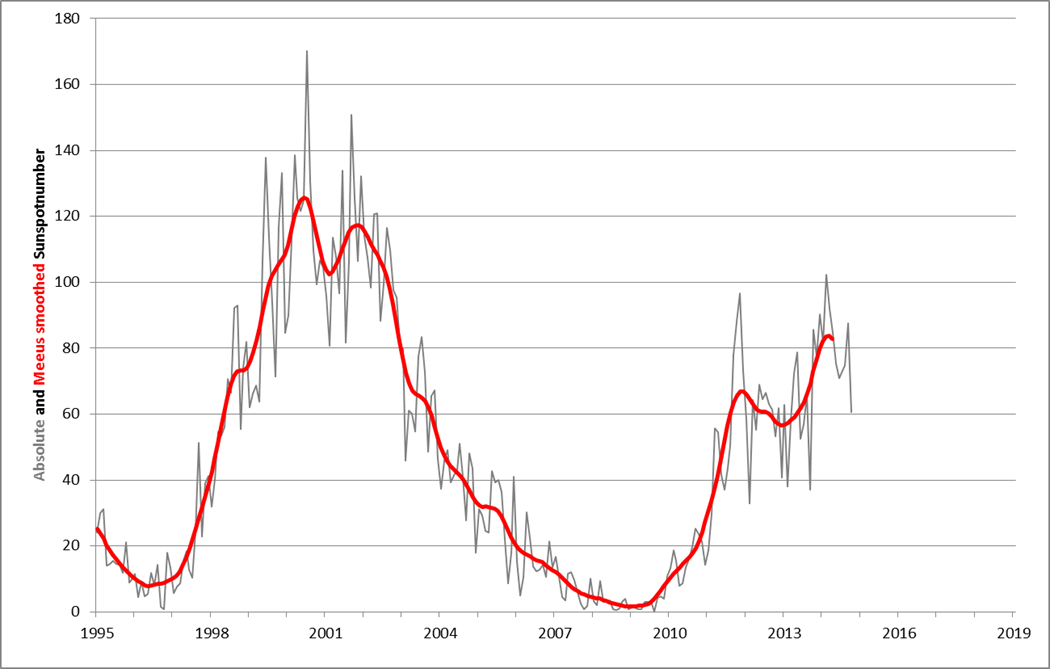
This maximum is quite a bit higher than the one recorded late 2011, as many solar observers will certainly confirm. The 2014 smoothed maximum seems to be about 83, whereas the one in 2011 only reached 66. This figure of "83" is very close to the maximum sunspot number predicted by the international team back in 2008-2009 (see this page at http://www.swpc.noaa.gov/SolarCycle/SC24/). The recent maximum was mainly due to increased activity on the southern solar hemisphere (red curve in graph underneath), whereas high activity on the northern hemisphere (blue curve) was the cause of the 2011 maximum.
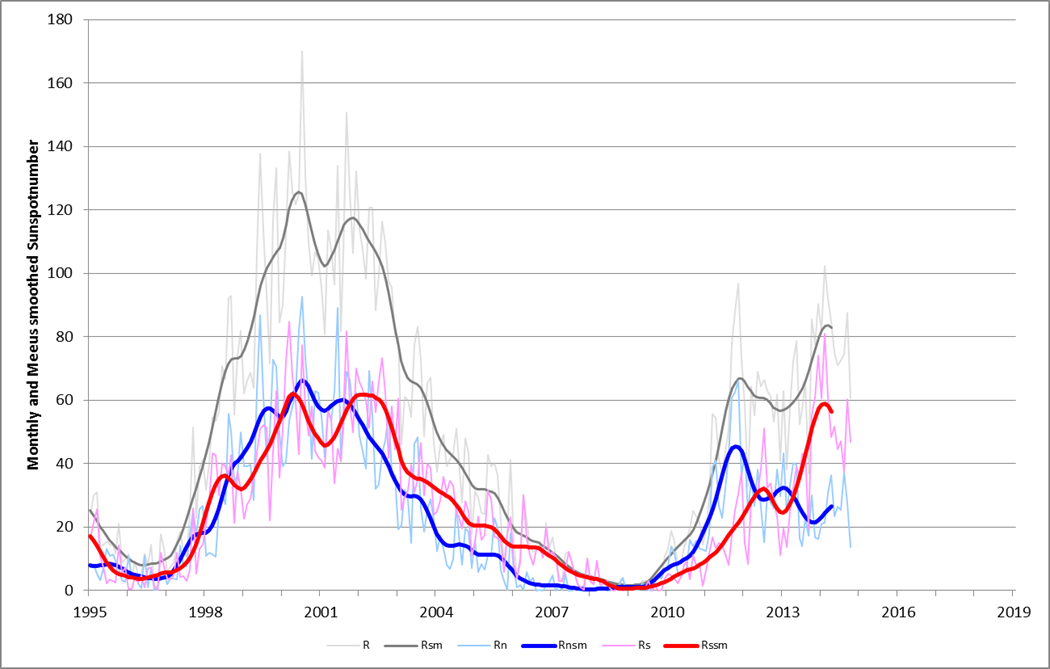
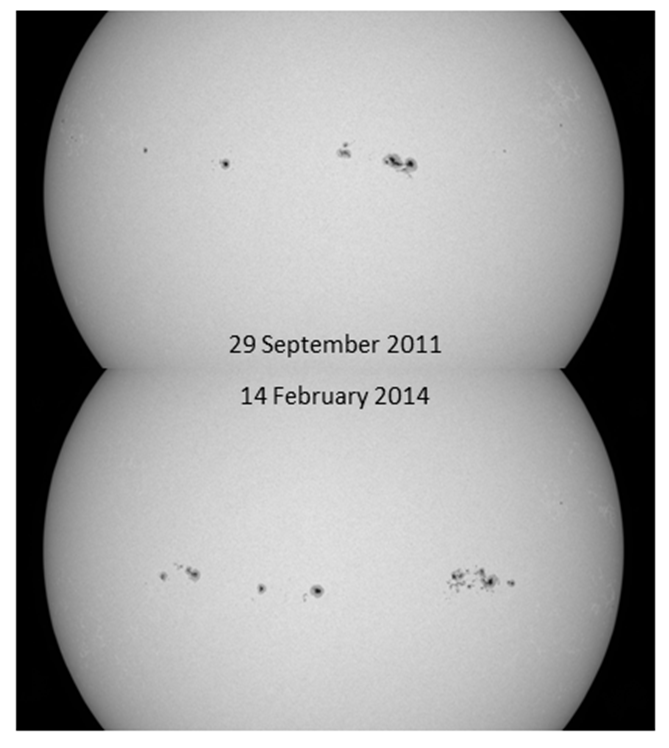
Many large sunspot groups have appeared during this cycle maximum, and –of course- the solar cycle is not finished yet! Underneath a few examples of big groups in SC24 producing at least one X-class ("eXtreme") flare. From left to right and from top to bottom: NOAA 1522 (July 2012), NOAA 1429 (March 2012), NOAA 1944 (January 2014), and of course NOAA 2192 (October 2014). So far, the largest X-class flare (X6.9 - image underneath) occurred on 9 August 2011 and was produced by NOAA 1263.
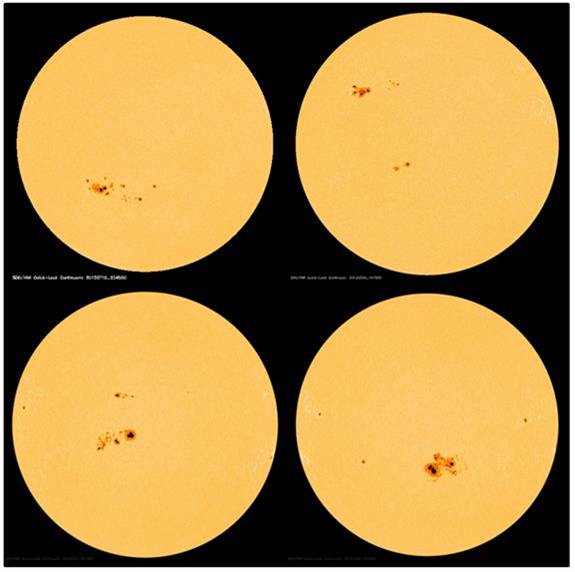
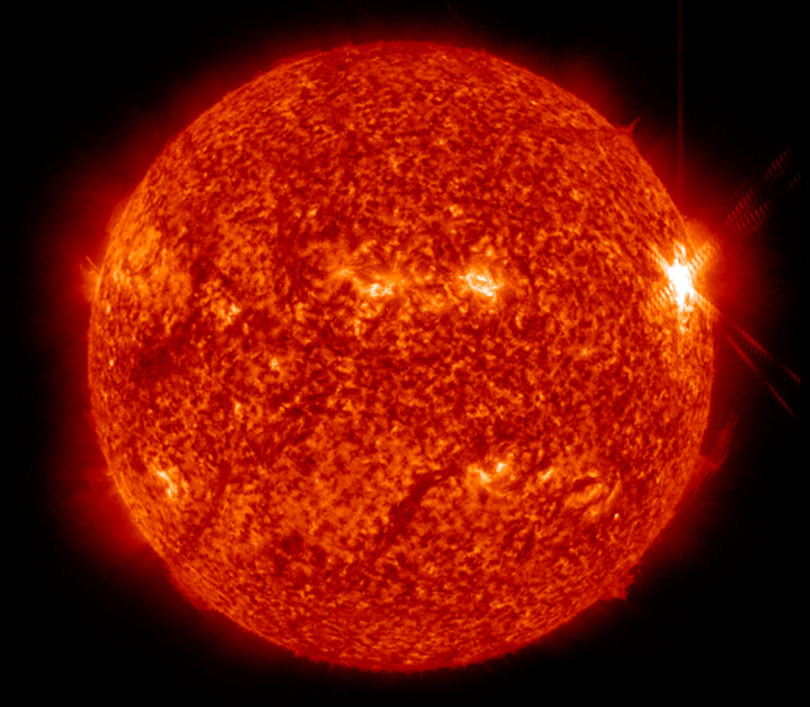
It does not happen very often that in a single month, the Sun produces more than 3 X-class flares. In fact, since measurements started in 1976, there have been only about 70 such months - as can be seen from the yellow and red dots superposed on the smoothed sunspot number in graph underneath. Seven of those have occurred during the ongoing SC24, with the latest in October due to famous NOAA 2192 flaring activity (6 X-class flares). However, as one can see from graph underneath, no month with 10 or more X-class flares (red dots) has occurred so far this SC. The red dots in the graph underneath show that SC21 had 3 such months, SC22 two, and SC23 only one. Amazingly, that one was not related to one of the Halloween groups, but to sunspot group NOAA 0808 that appeared in September 2005.
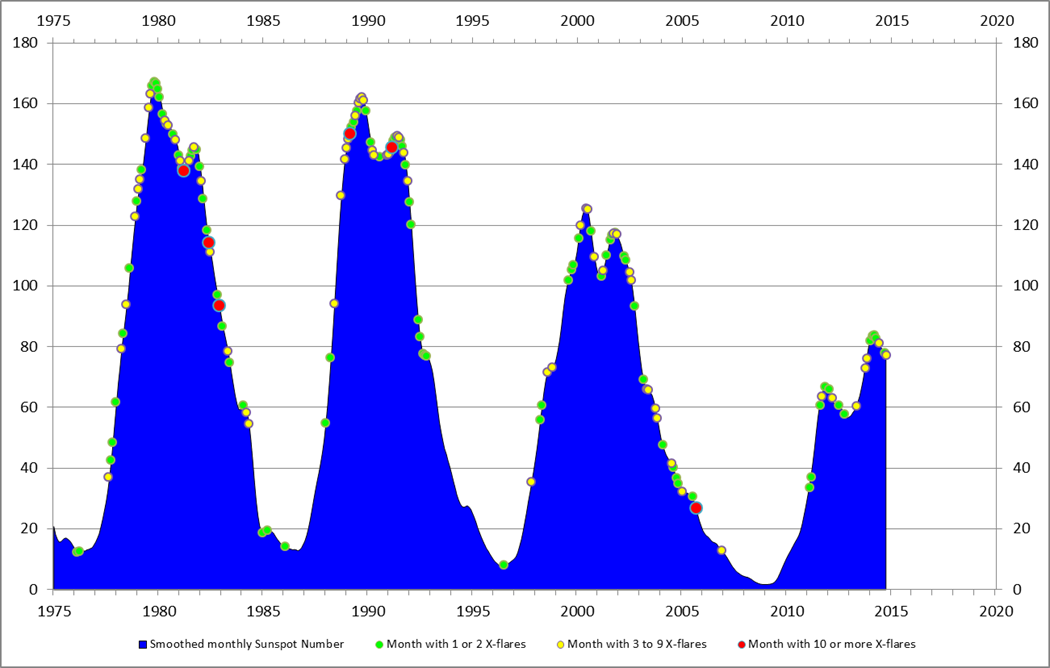
Credits - SILSO (http://sidc.oma.be/silso/), SDO (http://sdo.gsfc.nasa.gov/data/aiahmi/)
From 17 to 21 November, more than 350 scientists from all over the world will gather in Liège, Belgium to discuss the newest insights in space weather. They try to predict solar storms and understand how these storms travel through space and can impact the Earth. Space weather is not only of interest to scientists, but it is also important for companies that, for example, depend on GPS navigation and accurate timings.
Just this week, a very big sunspot is visible again. At the end of October, this spot, which was visible with the naked eye, caused commotion because it produced many extreme solar flares. Satellite operators were alarmed and prepared for potentially large particle storms that luckily did not materialize. This super sunspot group, which they hope to watch live, will certainly be a hot topic of discussion.
Please have a look at
http://www.stce.be/esww11
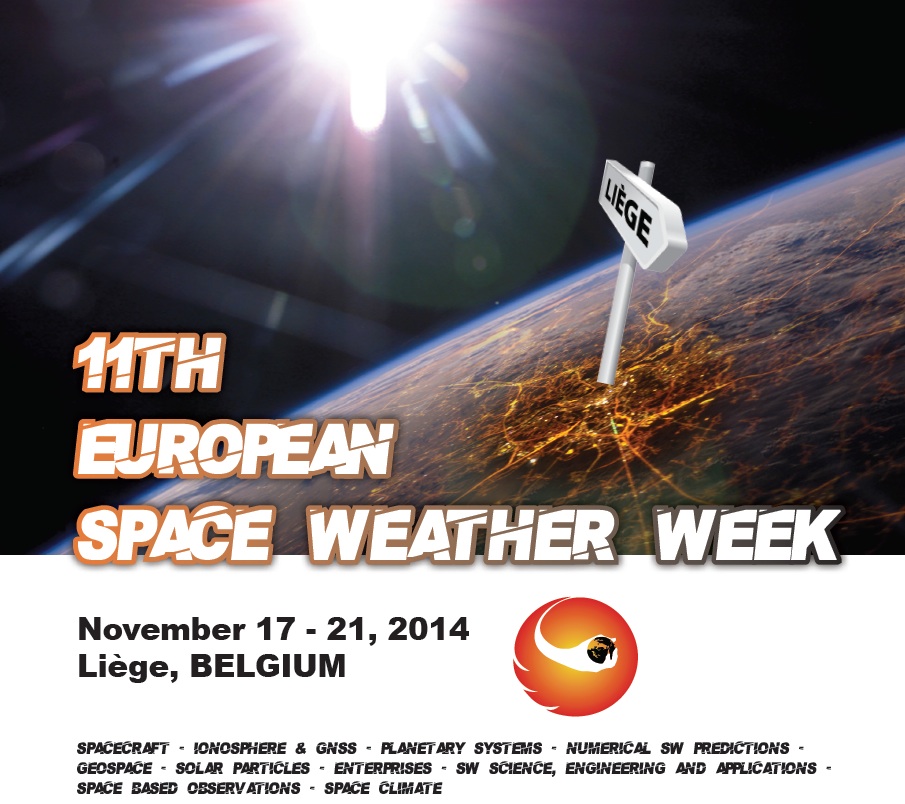
The week was dominated by NOAA active region NOAA 2205 which over the course of the week moved to its current position near the central meridian. It produced 13 M-class flares scattered over that period and an X1.6 flare peaking at 17:26UT on 7 November. More details and a movie of this event can be found at http://stce.be/news/282/welcome.html The other groups produced only a few low-level C-class flares.
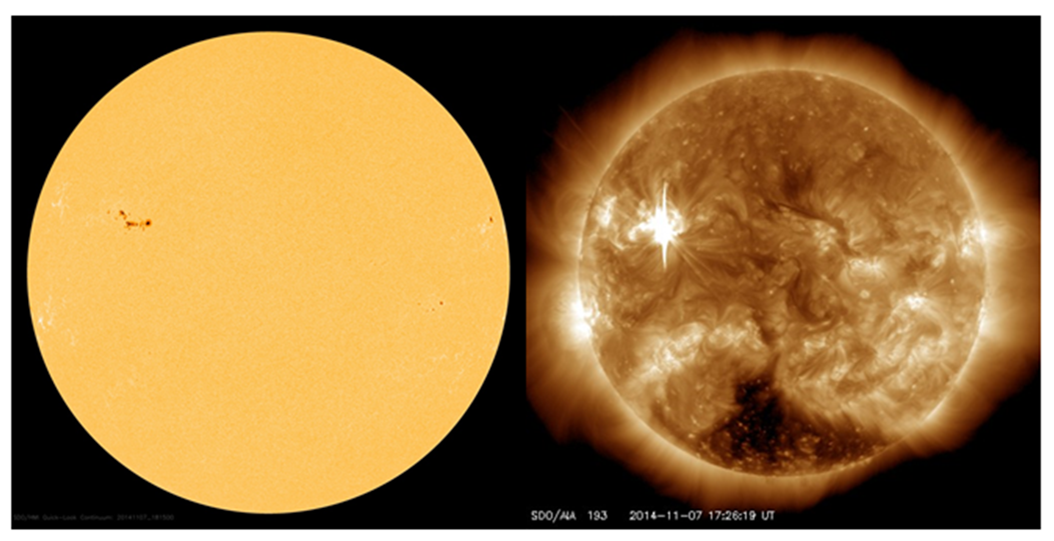
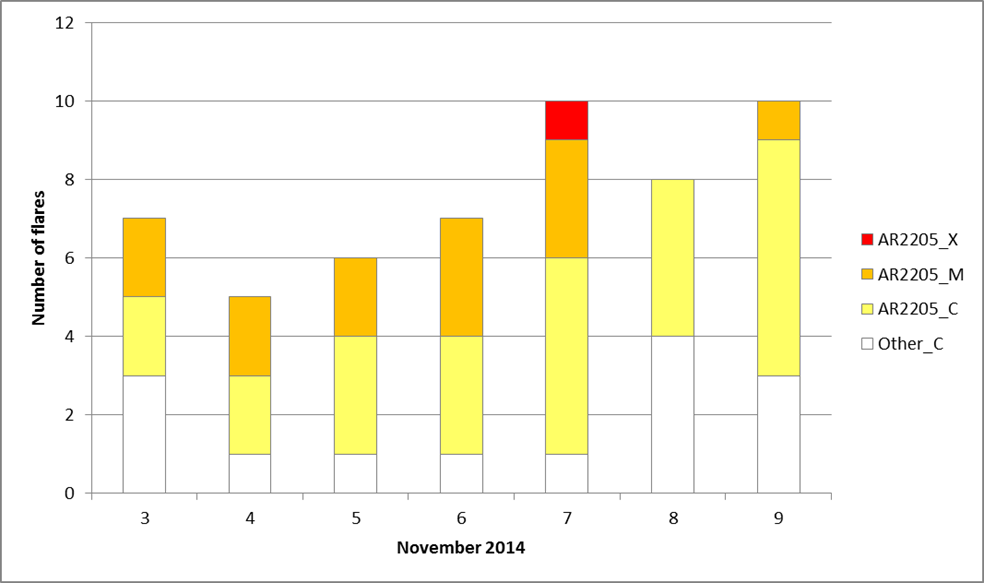
Multiple coronal mass ejections (CMEs) were associated to NOAA 2205's flaring activity, though mostly not very powerful and propagating well eastward of the Sun-Earth line.
Only the CME from 7 November associated to the X-class flare is believed to have an Earth directed component. Its first appearance in SOHO/LASCO C2 coronagraph is at 18:08UT, but the actual onset was missed due to a 30 minute data gap just before. This partial halo CME was directed to the northeast and had an angular width of at least 180 degrees. CACTus initially reported this as a full halo, because it erroneously included high speed components in the southwestern direction from a different event.
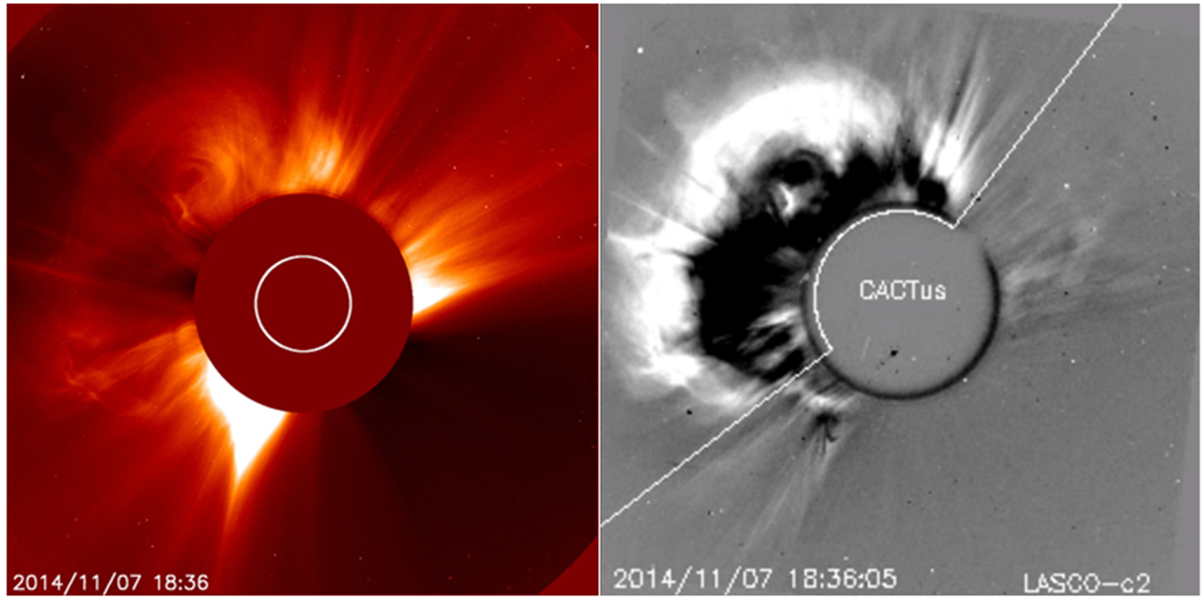
| DAY | BEGIN | MAX | END | LOC | XRAY | OP | 10CM | TYPE | Cat | NOAA |
| 03 | 1123 | 1153 | 1217 | M2.2 | II/2 | 2205 | ||||
| 03 | 2215 | 2240 | 2253 | M6.5 | 180 | III/1II/1 | 2205 | |||
| 04 | 0759 | 0838 | 0851 | N15E82 | M2.6 | SF | CTM/1VI/1 | 2205 | ||
| 04 | 0852 | 0904 | 0913 | N15E82 | M2.3 | 1F | 2205 | |||
| 05 | 0926 | 0947 | 0955 | N20E68 | M7.9 | 1N | 240 | II/2 | 2205 | |
| 05 | 1850 | 1944 | 2015 | N17E65 | M2.9 | 1N | VI/1II/1 | 2205 | ||
| 06 | 0129 | 0139 | 0154 | N15E58 | M3.2 | 2N | III/1 | 2205 | ||
| 06 | 0332 | 0346 | 0402 | N17E58 | M5.4 | 1N | II/1IV/1 | 2205 | ||
| 06 | 2153 | 2216 | 2234 | N14E45 | M2.5 | 1N | 200 | III/2 | 2205 | |
| 07 | 0205 | 0249 | 0332 | N17E50 | M2.7 | 2N | VI/1 | 2205 | ||
| 07 | 0412 | 0425 | 0438 | M2.0 | 2205 | |||||
| 07 | 1013 | 1022 | 1030 | N15E43 | M1.0 | SF | 2205 | |||
| 07 | 1653 | 1726 | 1734 | X1.6 | 72 | II/2IV/1 | 2205 | |||
| 09 | 1524 | 1532 | 1538 | N18E14 | M2.3 | 1B | 2205 |
| LOC: approximate heliographic location | TYPE: radio burst type |
| XRAY: X-ray flare class | Cat: Catania sunspot group number |
| OP: optical flare class | NOAA: NOAA active region number |
| 10CM: peak 10 cm radio flux |
Solar flare activity fluctuated between low and high during the week.
In order to view the activity of this week in more detail, we suggest to go to the following website from which all the daily (normal and difference) movies can be accessed: http://proba2.oma.be/ssa
This page also lists the recorded flaring events.
A weekly overview movie can be found here (SWAP week 241).
http://proba2.oma.be/swap/data/mpg/movies/WeeklyReportMovies/WR241_Nov03_Nov09/weekly_movie_2014_11_03.mp4
Details about some of this week's events, can be found further below.
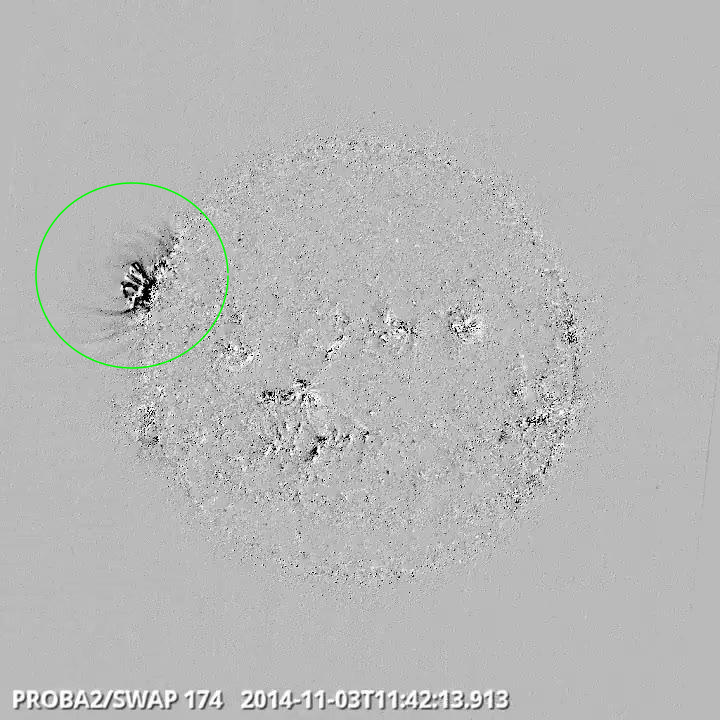
Eruption on the north east quad @ 11:42 SWAP difference image
Find a movie of the events here (SWAP difference movie)
http://proba2.oma.be/swap/data/mpg/movies/20141103_swap_diff.mp4
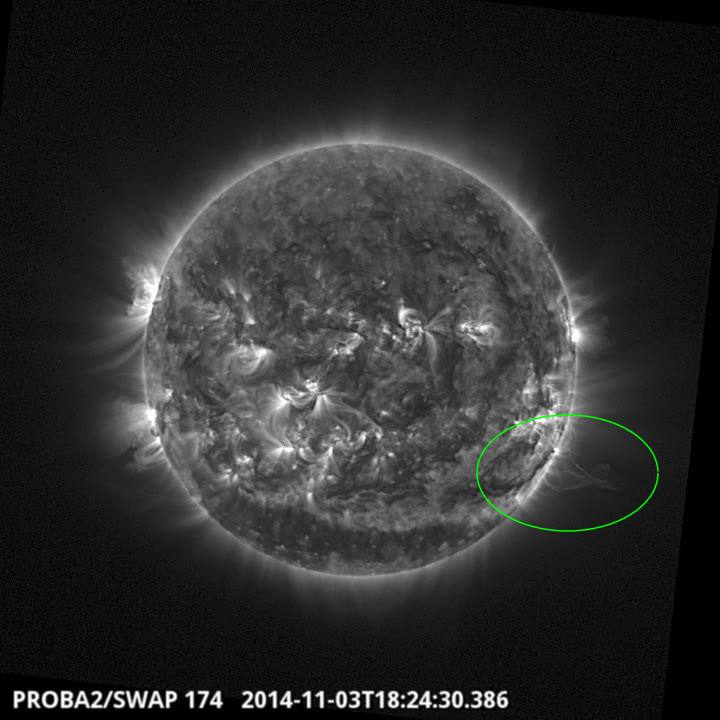
Failed eruption on the west quad @ 18:24 SWAP image
Find a movie of the events here (SWAP movie)
http://proba2.oma.be/swap/data/mpg/movies/20141103_swap_movie.mp4
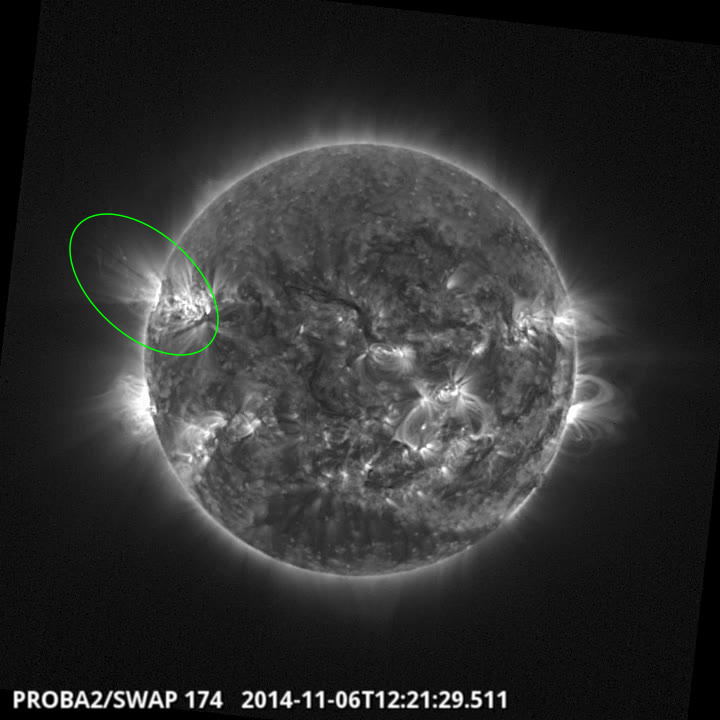
Eruption in the north east quad @ 12:21 SWAP image
Find a movie of the event here (SWAP movie)
http://proba2.oma.be/swap/data/mpg/movies/20141106_swap_movie.mp4
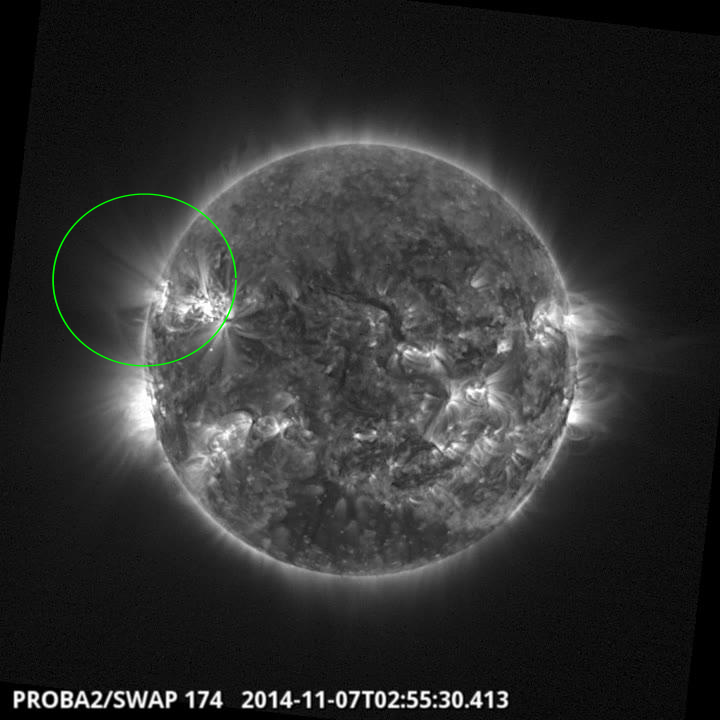
Eruption in the north west quad @ 02:55 SWAP image
Find a movie of the event here (SWAP movie)
http://proba2.oma.be/swap/data/mpg/movies/20141107_swap_movie.mp4
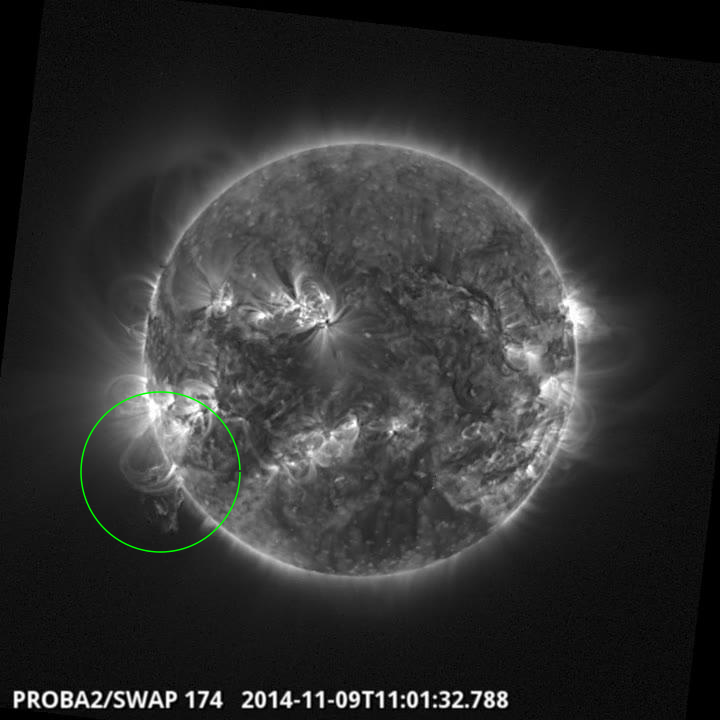
Failed eruption in the south west quad @ 11:01 SWAP image
Find a movie of the event here (SWAP movie)
http://proba2.oma.be/swap/data/mpg/movies/20141109_swap_movie.mp4
Except for some minor coronal hole high speed influences, solar wind was mostly at nominal values with some transients starting late on 3 November, possibly marking the impact of the 1 November eruption. Geomagnetic conditions were mostly quiet to unsettled (both NOAA Kp and local K Dourbes between 0 and 3), with an active period (both NOAA Kp and local K Dourbes values at 4) on 4 November associated to the aforementioned transient from the 1 November CME.
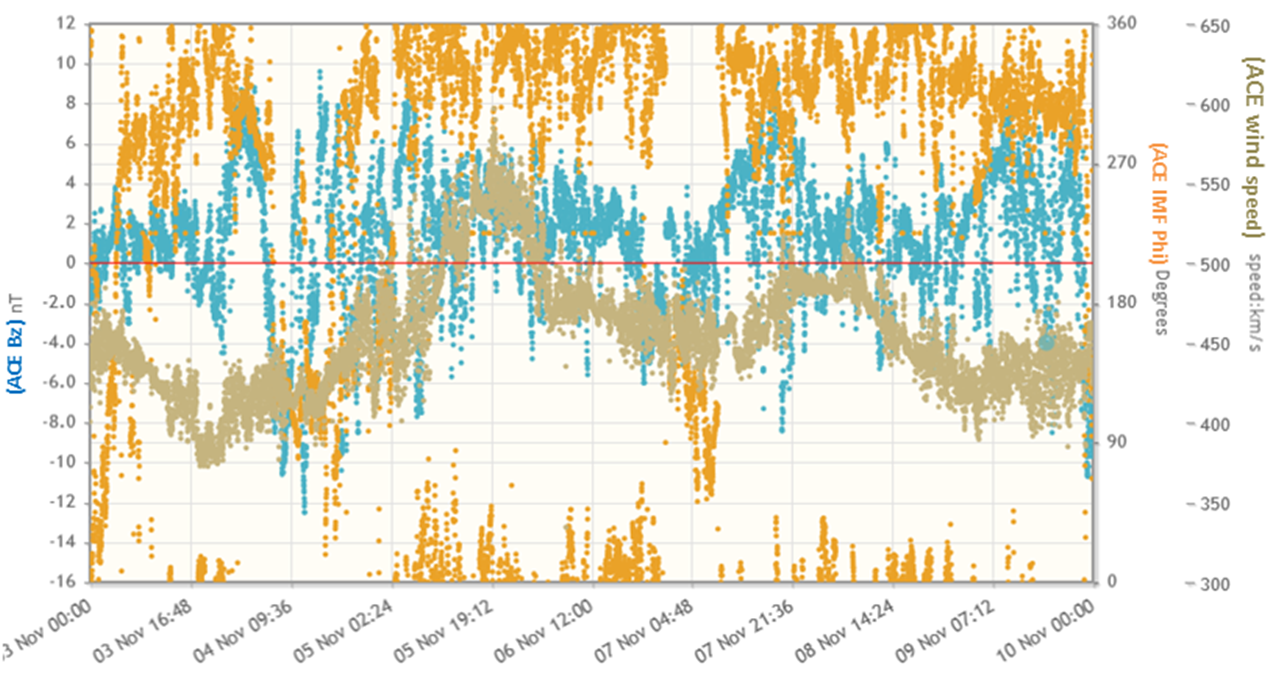
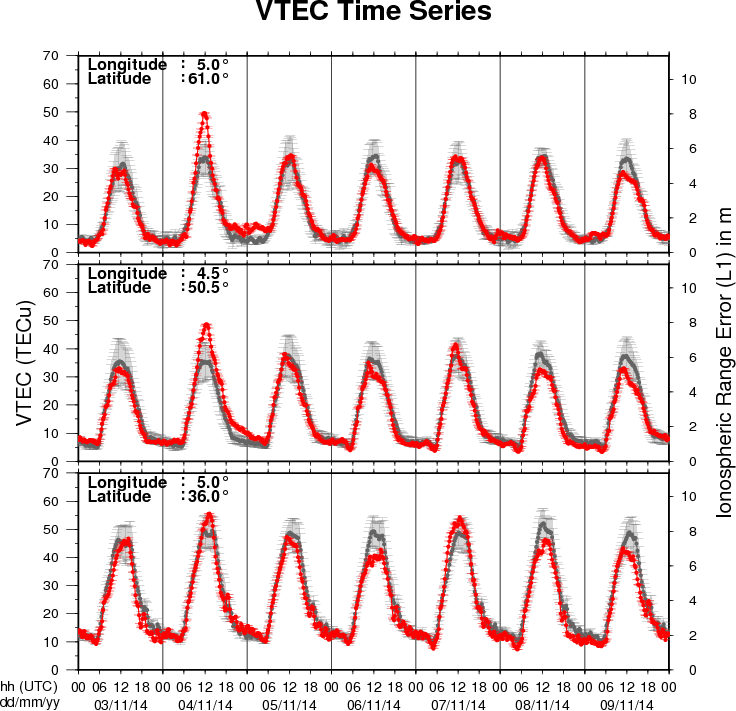
The figure shows the time evolution of the Vertical Total Electron Content (VTEC) (in red) during the last week at three locations:
a) in the northern part of Europe(N61°, 5°E)
b) above Brussels(N50.5°, 4.5°E)
c) in the southern part of Europe(N36°, 5°E)
This figure also shows (in grey) the normal ionospheric behaviour expected based on the median VTEC from the 15 previous days.
The VTEC is expressed in TECu (with TECu=10^16 electrons per square meter) and is directly related to the signal propagation delay due to the ionosphere (in figure: delay on GPS L1 frequency).
The Sun's radiation ionizes the Earth's upper atmosphere, the ionosphere, located from about 60km to 1000km above the Earth's surface.The ionization process in the ionosphere produces ions and free electrons. These electrons perturb the propagation of the GNSS (Global Navigation Satellite System) signals by inducing a so-called ionospheric delay.
See http://stce.be/newsletter/GNSS_final.pdf for some more explanations ; for detailed information, see http://gnss.be/ionosphere_tutorial.php
Presentation, in Dutch given at the open doors of the Space Pole, Brussels, Belgium, 2014
http://www.spaceweather.eu/en/repository/show?id=548
Presentation, in Dutch given at the open doors of the Space Pole, Brussels, Belgium, 2014
http://www.spaceweather.eu/en/repository/show?id=550
Presentation, in Dutch, given at the open doors of the Space Pole, Belgium, 2014
http://www.spaceweather.eu/en/repository/show?id=551
Presentation, in Dutch, given at the open doors of the Space Pole, Belgium, 2014
http://www.spaceweather.eu/en/repository/show?id=552
http://www.spaceweather.eu/en/repository/show?id=553
Start : 2016-07-30 - End : 2016-08-07
The 41st COSPAR Scientific Assembly will be held in Istanbul,
Turkey from 30 July - 7 August 2016. This Assembly is open to all
bona fide scientists.
Website:
https://www.cospar-assembly.org/